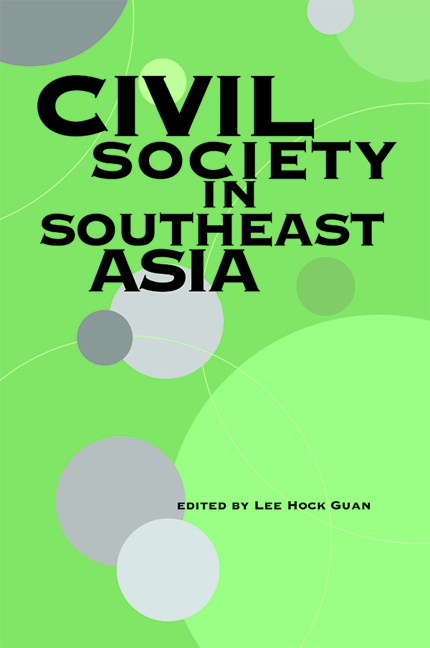Book contents
- Frontmatter
- Contents
- Preface
- About the Contributors
- 1 Introduction: Civil Society in Southeast Asia
- 2 Islam, Constitutional Democracy, and the Islamic State in Malaysia
- 3 Cracks in the Wall of Separation?: The Church, Civil Society, and the State in the Philippines
- 4 New Buddhism, Urban Space, and Virtual Civil Society
- 5 Women's Movement in the Philippines and the Politics of Critical Collaboration with the State
- 6 Participation of the Women's Movement in Malaysia: The 1999 General Election
- 7 Civil Society Effectiveness and the Vietnamese State — Despite or Because of the Lack of Autonomy
- 8 Relationship between State and Civil Society in Singapore: Clarifying the Concepts, Assessing the Ground
- 9 Civil Society in Malaysia: An Arena of Contestations?
- 10 Ethnicity and the Civil Rights Movement in Indonesia
- 11 Civil Society Discourse and the Future of Radical Environmental Movements in Thailand
- Index
7 - Civil Society Effectiveness and the Vietnamese State — Despite or Because of the Lack of Autonomy
Published online by Cambridge University Press: 03 November 2017
- Frontmatter
- Contents
- Preface
- About the Contributors
- 1 Introduction: Civil Society in Southeast Asia
- 2 Islam, Constitutional Democracy, and the Islamic State in Malaysia
- 3 Cracks in the Wall of Separation?: The Church, Civil Society, and the State in the Philippines
- 4 New Buddhism, Urban Space, and Virtual Civil Society
- 5 Women's Movement in the Philippines and the Politics of Critical Collaboration with the State
- 6 Participation of the Women's Movement in Malaysia: The 1999 General Election
- 7 Civil Society Effectiveness and the Vietnamese State — Despite or Because of the Lack of Autonomy
- 8 Relationship between State and Civil Society in Singapore: Clarifying the Concepts, Assessing the Ground
- 9 Civil Society in Malaysia: An Arena of Contestations?
- 10 Ethnicity and the Civil Rights Movement in Indonesia
- 11 Civil Society Discourse and the Future of Radical Environmental Movements in Thailand
- Index
Summary
INTRODUCTION
In this chapter, the term “state” firstly refers to the totality of political authority in Vietnam. Although the state in a socialist country is usually so dominated by its communist party that it has spawned the term “partystate”, I have opted for just simply the “state”. The term “state” should not be confused, as it tends to be in ordinary language, with the term “government”. Institutionally, the state is made up of the party and the government. The party, in this instance, is the Vietnam Communist Party (VCP) and the government comprises the legislative organ (National Assembly) and the administrative organs (the Prime Minister's Office and the ministries or committees under its purview). Then there are the mass organizations that represent interest groups, such as women, youth, religion, and workers. They are controlled by the party but are not, formally speaking, of the party or of the government. However, I would also consider these mass organizations as part of the state. These institutions are what Benedict J. Tria Kerkvliet (2001, p. 270) calls the “physical and structural aspects of the state”. He also identifies the “ideological dimension and psychological impact of a state” and reminds us that “the state also has purposes, plans, objectives”. In this chapter, the definition of the “state” will encompass such a broad, inclusive meaning.
Writing of state–society relations in Vietnam, Kerkvliet (1995b, pp. 40– 41) argues that while at one level it makes sense to see state and society as distinct and relating to each other as separate entities, at another level it is necessary to recognize that “state and society are often intermingled”. This lack of clear delineation derives from the way in which communist regimes have structured their societies (Nathan 1990, pp. 5–6). The state tends to develop a broad network of organizations to ensure that the ruling communist party penetrates into every possible sector and level of society, for example, party cells at the workplace and in the neighbourhood. The extent to which party penetration is carried out varies from one socialist regime to another. Within any one state, differences also exist over time. Generally speaking, the praxis of the ideology sees the socialist state determined to penetrate society. Under such circumstances, civil society finds it hard to thrive.
- Type
- Chapter
- Information
- Civil Society in Southeast Asia , pp. 144 - 166Publisher: ISEAS–Yusof Ishak InstitutePrint publication year: 2004



